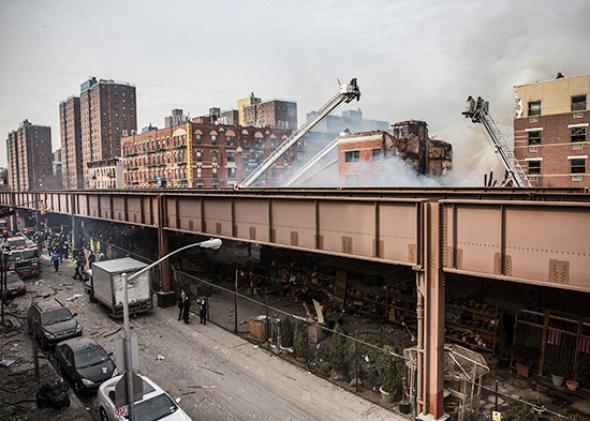An explosion in Harlem this morning that led to the collapse of two five-story buildings may have been caused by a gas leak. The New York Times reports that tenants smelled gas last night, but went to sleep when they couldn’t find the source and the smell dissipated. And a Con Edison spokesperson told the Times that a resident who lives near the affected buildings called the utility at 9:13 this morning—about 20 minutes before the explosion—to report a strong gas smell.*
This may be a warning for New York City and other urban areas. A report out Tuesday from the Center for an Urban Future reveals that New York City’s infrastructure is extremely old. It may not be surprising, exactly, given that New York is known to have been densely populated for hundreds of years, but seeing it all laid out is still pretty stunning.
The report notes that New York’s 6,300 miles of gas mains are 56 years old and that leaks in the system cause Con Ed to lose more than 2 percent of the gas it sends to customers every year. Additionally, 60 percent of New York gas mains are made of unprotected steel or cast iron, which are no longer used in gas main fabrication because they spring too many leaks.
And New York isn’t the only city with these problems. In January, researchers from Duke and Boston University mapped Washington, D.C.’s gas leaks and found 5,893 places where the city’s buried gas mains were leaking enough methane to detect it from the street. They also noted that many sites had the potential to cause explosions. A group including several of the same researchers had similar findings about Boston in 2012.
At a news conference about the building collapse in Harlem, Mayor Bill de Blasio said, “This is a tragedy of the worst kind because there was no indication in time to save people.” And it’s mostly true that this accident came without much apparent warning. But aging infrastructure is a known problem. And the Times looked at New York Buildings Department records for one of the collapsed buildings, which showed that as of 2008 the structure had “several vertical cracks which is hazardous for the safety of the structure.”
Aging infrastructure problems are certainly difficult to resolve because of high costs, but doing more maintenance is clearly worthwhile, whether the Harlem explosion turns out to have been caused by a gas leak, structural problems or something else. The Center for an Urban Future writes that “to ensure the high quality of life current residents have come to expect, Mayor Bill de Blasio, Governor Andrew Cuomo and other government officials will need to make investing in the city’s aging infrastructure a major priority.”
If it wasn’t worth addressing before, the Harlem accident—which left at least two dead and many injured—should make it worth it now.
*Correction, March 12, 2014: Due to an editing error, this post originally misstated that a resident of a collapsed building called to report a smell of gas 20 minutes before the explosion. The call came from someone who lives nearby, but not in an affected building.
